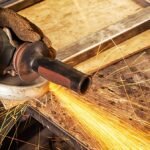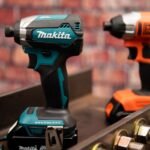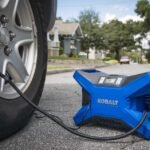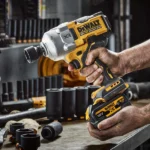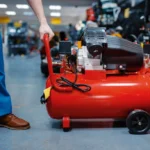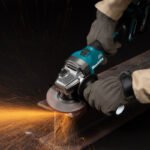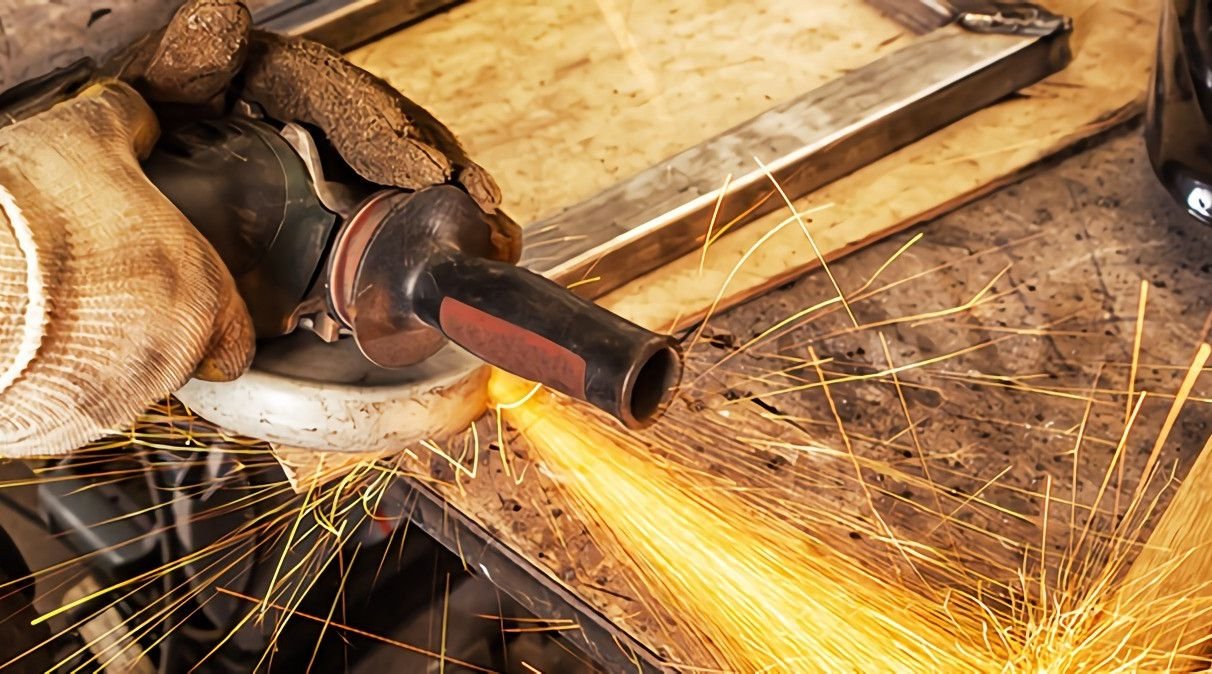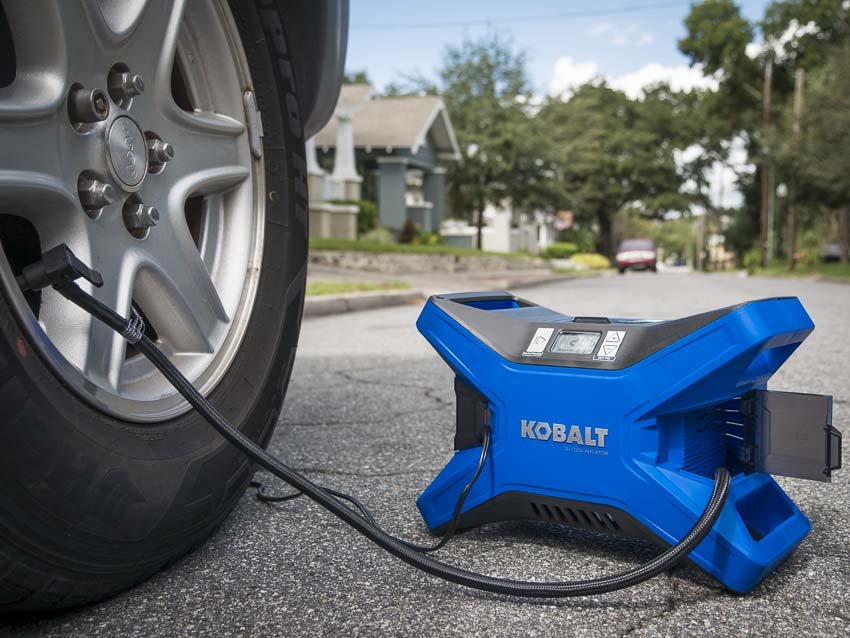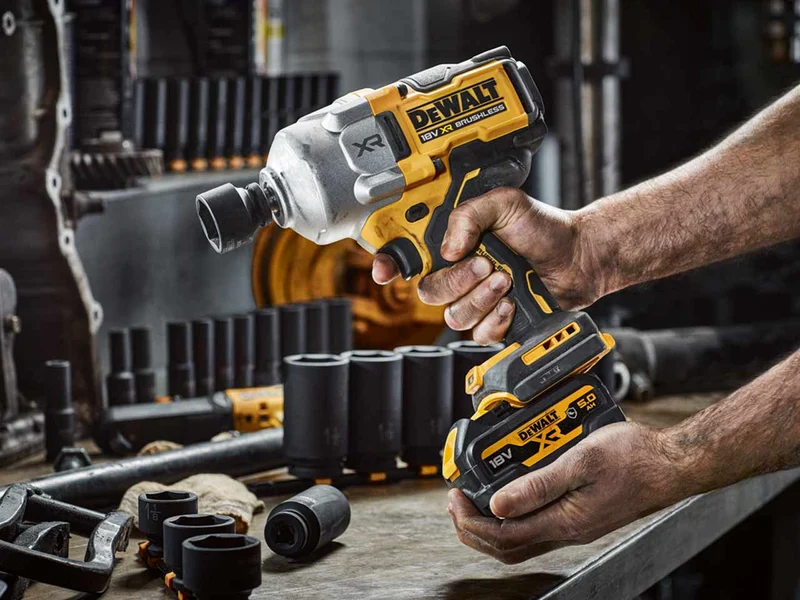Angle grinders are indispensable tools in the welding industry, known for their versatility and efficiency in handling various tasks. These power tools are essential not just for cutting and grinding, but also for polishing and finishing welds.
The ability to switch between different discs and attachments makes angle grinders incredibly adaptable to a range of welding projects. Whether you are preparing a surface, smoothing rough edges, or achieving a polished finish, an angle grinder can significantly enhance the quality of your work.
One of the critical aspects of welding is ensuring that the workpiece is properly prepared before any welding begins. This often involves cleaning the metal surfaces and removing any rust, paint, or other contaminants.
An angle grinder equipped with a wire brush attachment can efficiently perform this task, leaving a clean surface ready for welding. After welding, these tools are equally valuable in grinding down weld beads, smoothing joints, and blending the welded areas seamlessly with the surrounding metal.
Investing in a high-quality angle grinder is crucial for achieving professional results. A good angle grinder not only offers power and durability but also provides features that enhance safety and ease of use.
Characteristics such as adjustable guards, anti-vibration handles, and variable speed controls can make a significant difference in the user’s experience and the outcome of the welding project.
Therefore, selecting the best angle grinder for welding requires careful consideration of these features and the specific needs of your projects.
In the following sections, we will delve into the top picks for the best angle grinder for welding, highlighting their unique features and benefits. By understanding the importance and functionality of these tools, you can make an informed decision and elevate the quality of your welding work.
Table of Contents
Key Features to Look for in an Angle Grinder
When selecting the best angle grinder for welding, several key features should be carefully evaluated to ensure optimal performance and usability.
A crucial aspect is the power and motor efficiency of the tool. Angle grinders with robust motors, typically measured in amps or watts, offer higher efficiency and can handle more demanding tasks.
A motor with higher power also contributes to a longer lifespan of the tool, making it a worthwhile investment for serious welding projects.
Speed settings are another important feature to consider. Variable speed control allows you to adjust the grinder’s speed based on the specific requirements of your welding task. This flexibility is particularly beneficial for working with different materials, as certain materials may require slower or faster speeds to achieve a clean cut or a smooth finish.
Disc size is also a pivotal factor. Common disc sizes range from 4.5 inches to 9 inches. Smaller discs are ideal for precision work and accessing tight spaces, whereas larger discs are better suited for heavy-duty tasks. Therefore, the choice of disc size should align with the type of welding projects you frequently undertake.
Ergonomics play a significant role in the overall usability of an angle grinder. A well-designed, comfortable grip can greatly reduce user fatigue during prolonged use. Additionally, features such as adjustable side handles and anti-vibration technology can enhance comfort and control, leading to more precise and safer operations.
Safety features should never be overlooked when choosing the best angle grinder for welding. Look for models equipped with features like safety guards, automatic shut-off, and overload protection. These elements not only safeguard the user but also protect the tool from potential damage, ensuring a longer operational life.
By carefully considering these essential features—power and motor efficiency, speed settings, disc size, ergonomics, and safety features—you can select the most suitable angle grinder that meets your welding needs and enhances your overall productivity and safety.
Top Angle Grinders for Welding: Our Picks
Finding the best angle grinder for welding is crucial for ensuring smooth and precise metalwork. To help you make an informed decision, we have compiled a list of top angle grinders that cater specifically to welding applications.
These selections represent a balance between high-end and budget-friendly options, each excelling in different aspects such as power, durability, and ease of use.

1. DEWALT DWE402 4-1/2-Inch 11-Amp Angle Grinder
Renowned for its robust performance, the DEWALT DWE402 is an 11-amp grinder that delivers 11,000 RPM. It features a dust ejection system to increase durability and a one-touch guard for seamless adjustments. The powerful motor and ergonomic design make it an excellent choice for welding tasks.
Pros: High power, durable construction, ergonomic design.
Cons: Slightly heavier than other models, higher price point.
This grinder stands out due to its reliability and power, making it ideal for professional welders.
2. Makita 9557PBX1 4-1/2-Inch Angle Grinder
The Makita 9557PBX1 combines power and convenience, offering a 7.5-amp motor that delivers up to 11,000 RPM. Its compact and lightweight design ensures ease of handling, while the labyrinth construction protects the motor and bearings from dust and debris.
Pros: Lightweight, affordable, versatile.
Cons: Lower power compared to higher-end models.
This model is perfect for those who need a reliable yet budget-friendly option for welding applications.
3. Bosch 1375A 4-1/2-Inch Angle Grinder
The Bosch 1375A is a compact yet powerful grinder featuring a 6-amp motor that delivers 11,000 RPM. Its slim design and ergonomic grip make it easy to maneuver, enhancing user comfort during prolonged use. Additionally, it includes a lock-on slide switch for continuous operation.
Pros: Lightweight, comfortable grip, affordable.
Cons: Less powerful compared to other high-end models.
Ideal for light to medium welding tasks, this grinder offers great value for money.
4. Metabo WEV15-125 HT 5-Inch Angle Grinder
The Metabo WEV15-125 HT is a high-performance grinder that boasts a 13.5-amp motor and a variable speed option ranging from 2,800 to 11,000 RPM. It features an electronic safety clutch and an integrated auto-stop carbon brush system for extended tool life.
Pros: Variable speed, safety features, powerful motor.
Cons: Higher price point, heavier.
For those seeking precision and advanced safety features, this grinder is an exceptional choice.
5. Black & Decker BDEG400 4-1/2-Inch 6-Amp Angle Grinder
The Black & Decker BDEG400 offers a 6-amp motor delivering 10,000 RPM. It includes a metal gear case for added durability, a spindle lock for easy accessory changes, and a three-position side handle for improved control and comfort.
Pros: Budget-friendly, durable, easy to handle.
Cons: Lower power, fewer advanced features.
This grinder is an excellent entry-level option for hobbyists and DIY enthusiasts needing a reliable tool for occasional welding tasks.
Each of these angle grinders brings unique features and benefits to welding applications, ensuring that you can find the best angle grinder for welding to suit your specific needs and budget.
Comparing Corded vs. Cordless Angle Grinders
When it comes to selecting the best angle grinder for welding, understanding the differences between corded and cordless models is crucial. The choice between these two types hinges on factors such as convenience, power supply, mobility, and the specific requirements of your welding projects.
Cordless angle grinders offer unparalleled convenience and mobility. Powered by rechargeable batteries, these grinders are ideal for worksites where access to electrical outlets is limited or non-existent. Their portability makes them perfect for tasks that require frequent movement or for welding in remote locations.
However, the trade-off for this flexibility is the limited battery life, which can necessitate frequent recharges or battery swaps during extended projects.
Additionally, cordless models may not always deliver the same consistent power output as their corded counterparts, particularly when the battery is nearing depletion.
On the other hand, corded angle grinders are known for their consistent power supply and often greater durability. Plugging directly into an electrical outlet, these grinders provide a steady stream of power, making them suitable for long, continuous use without the need for battery replacements or recharges.
This consistent performance is particularly beneficial for heavy-duty tasks or prolonged welding sessions. Furthermore, corded grinders are typically more robust, designed to withstand rigorous use over time. However, the necessity of a power outlet can limit their operational range and may require the use of extension cords, potentially complicating the workspace.
In deciding between corded and cordless angle grinders, consider the nature of your welding projects. For on-the-go welding tasks or jobs in isolated areas, a cordless angle grinder may be the best fit, offering the freedom to work without constraints.
Conversely, for intensive welding activities that demand sustained power, a corded angle grinder is likely the more suitable option, ensuring reliable performance throughout your work.
Maintenance Tips for Your Angle Grinder
Maintaining your angle grinder is essential to guarantee its longevity and optimal performance, especially when you rely on it for welding applications. Regular upkeep not only ensures safety but also enhances the tool’s efficiency. Here are some comprehensive maintenance tips to keep your angle grinder in top condition.
Firstly, routinely clean your angle grinder to prevent dust and debris from accumulating. After each use, wipe down the tool with a dry cloth and use compressed air to remove any particles lodged in vents and crevices. This step is particularly crucial when working in dusty environments, as debris can congest the motor and reduce the grinder’s effectiveness.
Secondly, always inspect the discs before and after use. Check for any signs of wear, chipping, or damage. Replace discs that show significant wear or any structural issues, as compromised discs can lead to accidents or subpar performance.
Ensure that you are using the correct type of disc for your welding tasks to maximize the efficiency and safety of the best angle grinder for welding.
Lubricating the moving parts of your angle grinder is another critical maintenance task. Regularly applying a suitable lubricant to the spindle, bearings, and other moving components minimizes friction and prevents overheating.
This practice not only prolongs the tool’s life but also ensures smooth operation during demanding tasks.
Proper storage of your angle grinder is equally important. Store the tool in a dry, clean place away from moisture and extreme temperatures. Use a protective case or cover to shield it from dust and accidental damage. Additionally, ensure that the power cord is coiled neatly and free from kinks or cuts.
Lastly, familiarize yourself with common troubleshooting techniques. If your angle grinder experiences issues such as unusual noises, overheating, or reduced power, consult the user manual for guidance on resolving these problems.
Regularly checking for loose or worn parts can preempt many common issues, ensuring your grinder remains in optimal working condition.
By adhering to these maintenance tips, you can significantly extend the lifespan and performance of your angle grinder, making it a reliable tool for all your welding needs.
Safety Tips When Using an Angle Grinder
Ensuring safety is crucial when operating an angle grinder, particularly in welding applications. The first step in maintaining safety is the use of appropriate personal protective equipment (PPE). This includes wearing a face shield or safety goggles to protect your eyes from sparks and debris.
Additionally, heavy-duty gloves are essential to shield your hands from sharp edges and hot surfaces. A long-sleeved shirt, preferably flame-resistant, and sturdy work boots are also recommended to protect your skin and feet.
Proper handling and operational techniques are equally important. Always inspect the angle grinder before use, checking for any damage or wear on the disc or the tool itself. Secure the workpiece firmly to prevent any movement during the grinding process.
When starting the tool, ensure that you have a firm grip and maintain a balanced stance to handle the torque generated by the grinder. Avoid using excessive force; let the tool do the work to reduce the risk of kickback and potential injury.
Precautions should be taken to avoid common hazards associated with angle grinders. Never operate the tool without the guard in place, as it provides a crucial barrier between the grinder and your body.
Be mindful of your surroundings, ensuring that there are no flammable materials nearby that could ignite from sparks. Regularly clean the work area to prevent clutter, which can cause trips and falls.
Following manufacturer guidelines and local safety regulations is imperative for safe operation. Always use the correct disc for the material you are working on, and do not exceed the recommended speed rating for the disc.
Familiarize yourself with the angle grinder’s user manual, paying special attention to safety instructions and maintenance procedures. Adhering to local safety codes and standards will further ensure that you are operating within safe and legal parameters.
By incorporating these safety measures and using the best angle grinder for welding, you can significantly reduce the risk of accidents and injuries, ensuring a safe and efficient working environment.
When selecting the best angle grinder for welding, user reviews and feedback provide invaluable insights into real-world performance and durability. Welders often turn to online marketplaces, forums, and specialized communities to share their experiences, helping prospective buyers make informed decisions.
One of the most frequently praised aspects in user reviews is the power and efficiency of the angle grinder. Many welders commend models that offer consistent power output, which is crucial for smooth and efficient metalworking.
Users particularly appreciate angle grinders with high RPMs (revolutions per minute), noting that these models facilitate quicker and more precise cuts, making them ideal for welding tasks.
Durability and build quality are other critical factors highlighted by users. Welders often work in demanding environments that necessitate tools capable of withstanding harsh conditions.
Feedback indicates that angle grinders constructed with robust materials and featuring protective casings tend to receive higher satisfaction ratings. Users also value features like dust ejection systems, which prolong the lifespan of the tool by preventing debris from damaging internal components.
Ergonomics and ease of use are recurring themes in user feedback. Comfortable grip designs and lightweight models are frequently recommended, as they reduce user fatigue during extended periods of use. Additionally, models with adjustable guards and easy-to-replace accessories are lauded for their convenience, allowing welders to adapt their angle grinder to various tasks seamlessly.
However, not all feedback is positive. Some common complaints include excessive noise levels and overheating issues. Users often point out that while high-powered models are effective, they can sometimes generate more noise, which may require additional hearing protection.
Overheating is another concern, particularly for cheaper models that may not have efficient cooling systems. These aspects underscore the importance of balancing power and durability with user comfort and safety.
Overall, user reviews and feedback offer a comprehensive view of what to expect from different angle grinders. By considering these real-world insights, welders can choose the best angle grinder for welding that meets their specific needs and preferences.
Conclusion: Choosing the Right Angle Grinder for Your Needs
In conclusion, selecting the best angle grinder for welding is crucial for achieving optimal results in your projects. By carefully evaluating the features and specifications of different models, you can identify a tool that meets your specific requirements.
Factors such as power, disc size, speed, and ergonomics play significant roles in determining the suitability of an angle grinder for your welding tasks.
User reviews and expert opinions offer valuable insights into the performance and reliability of various angle grinders. These reviews can help you narrow down your choices and ensure that you invest in a tool that delivers consistent and efficient results.
Additionally, considering the ease of maintenance and availability of replacement parts is essential for the long-term functionality of your angle grinder.
We encourage you to take advantage of the comprehensive information provided in this guide to make an informed decision. Whether you are a professional welder or a DIY enthusiast, selecting the best angle grinder for welding can significantly enhance your productivity and the quality of your work.
Remember to prioritize your safety by choosing a tool with reliable safety features and adhering to proper usage guidelines.
We invite you to share your experiences and recommendations with fellow readers. Your insights can be invaluable in helping others make the right choice when it comes to selecting an angle grinder for their welding needs. By fostering a community of shared knowledge, we can collectively improve our welding projects and achieve better results.
